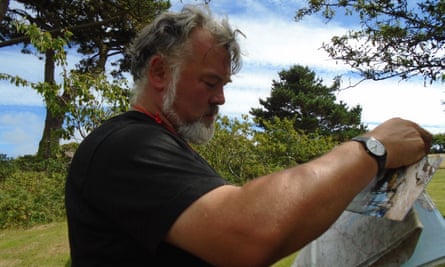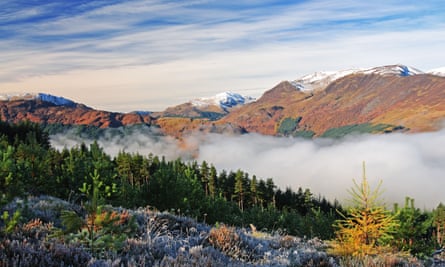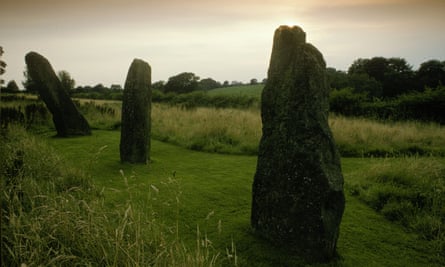Two books bestrode my childhood, and made me the man I am: The Magic Bridle, a collection of British and Irish myths retold by the folklorist Forbes Stuart, which ignited my six-year-old imagination in 1974, and Mysterious Britain by Janet and Colin Bord, published two years earlier, and part of a then burgeoning bookseller phenomenon of often unreliable Earth mysteries compendiums. Nonetheless, they set this particular boy off, seeking out ancient sites whenever possible. Now everything has wilted but I still have calves of iron, and I can identify the outline of a hilltop earthwork from a moving car on a motorway as surely as a falcon seeing a field mouse 500 feet below.
Through childhood and adolescence I worked towards my targets, assembling my own apostolic archive of similar but unrelated 70s texts, light on detail and heavy on conjecture. Where were these places of power? I would see them! “You and your old ruins!” my gran would cluck dismissively, as I politely requested we broke our Morris Marina journey southwest to the caravan site, at Stanton Drew or Glastonbury. And when I stumbled in my cub-scout shorts to find the Longstone Barrow, which I had only seen in a blurred pamphlet picture, my divorcee dad waited patiently in a car at the bottom of Challacombe Common, counting down the functional alcoholic hours to opening time. God bless him! Today I feel his pain. But we were all weird walking blind back then, confused men with their hands on the shoulders of the equally confused man in front, seeking silhouettes of standing stones in the mists of imaginary moors.

And then, in the closing hours of the 20th century, came Julian Cope’s The Modern Antiquarian, a landmark practical tome for the would-be site-seeker, served up in its own mud-proof slipcase, synthesising archaeology, folklore, grid references, helpful full-colour maps, parking advice and a small smidgeon of Cope’s own eccentric interpretations, often later validated by reluctantly admiring academics. The stones were stages! Rock and roll! It was a game-changer, and Cope opened up the crack in the Devil’s Grave of our folkloric landscape to all, like the wizard of Alderley Edge.
But Weird Walk is not The Modern Antiquarian. If anything, the three Weird Walkers, whoever they may be, have returned the love of folk tales, ancient sites and the perambulations that lead one to their locations even more defiantly to the realm of the gentleman and gentlewoman amateurs who first documented them. The sensibly shod 17th-century parson, mapping the megaliths between funerals and marriages, and the aristocratic antiquary, pleading with some Cornish farmer to spare the collapsed burial chamber whose capstone he had earmarked for a pigsty, would recognise the Weird Walkers as kindred spirits. No one knows who they are, or what they are doing.
And yet, in their costly boots and cagoules, they seem to have stumbled into something. They walk the landscape in the shadows of the seasons as we used to experience them before they blurred, reminding us of how we once measured out the increments of our humanity, and etched it into rock and earth, in the annual cycles of rotting and rebirth. When we lose this knowledge, we are lost. We’re probably lost anyway to be honest, but fuck it, let’s go down drunk and walking weird.
Fernworthy Forest, Dartmoor, Devon

Dartmoor is a weird place; temporal dislocation comes with the territory. Wayfinding is not easy among this gorse, these rambling tors and secluded brooks. And when an autumn mist descends, you can be transported: a bronze age farmer to your left, a medieval tin miner to your right, and up ahead the lord of the manor has antiquarian ambitions. He’s just repositioned those stones. The earth gnomes don’t approve.
The stretch of moor between the storied Warren House Inn and the foreboding interwar plantation of Fernworthy Forest is classic Dartmoor; the grasses are thick underfoot and marshy ground emerges without warning, saturated by the capricious weather. Long ago, the moorland here would have rolled uninterrupted and Fernworthy’s ancient monuments would have been as exposed as their neighbours at Merrivale or the Grey Wethers. Now, the break with the moor is absolute, and dark evergreens offer up an entrance out of a Grimm’s tale. Once inside, the silent monoculture can provide even the warmest October day with an eerie chill.
Near the edge of the forest sits Assycombe double stone row, Fernworthy’s planters helpfully leaving a gap between the saplings for the stones to breathe. Although little known, it is a remarkable monument that seems to tumble down its grassy hill, the irregular miniliths descending like a dragon’s spine from an initial menhir to a large blocking stone at the foot of the slope.
Assycombe is one of the many stone rows on Dartmoor thought by early antiquarians, such as Richard Polwhele, to be “Druid ways”. They are scattered across the landscape, sometimes barely discernible, but always potent in their imaginative value. Walking these ancient lines creates an access point, a connection to those who walked them long ago.

Following the track from Assycombe, deeper into the plantation, will eventually bring you to the reservoir that dominates the area. Built during the second world war, its construction was not without incident. Fernworthy Farm, which could trace its ancestry back to the Middle Ages, was among the buildings demolished to make way for the dam and reservoir. When it was standing, locals told of a curse laid upon the farm by the earth gnomes who dwell beneath the moor.
So infuriated were the gnomes by the quarrying of their finest granite to rebuild the farmhouse at Fernworthy that they stole the firstborn child of the farmer who had committed the sin. On Dartmoor, “don’t upset the gnomes” seems to come pretty high on the list of folk rules.
Working around the body of water as it lies today, it’s an easy stroll to the mysterious stone circle of Froggymead, its name nodding to its marshy location. A bronze age circle of some 29 stones, it is a wonderfully meditative place. Stone rows, albeit damaged by all that tree planting, can be seen to the north and south of the site. Froggymead (also known as Fernworthy stone circle) makes a vibe-laden picnic spot and, from here, there’s the option to continue out of the forest to the Grey Wethers.
Consisting of two stunning stone circles, the Grey Wethers are one of the megalithic highlights of this part of the world. Their position makes them even more appealing – you’re likely to be sharing the circles with relatively few visitors or perhaps only the skylarks that dance overhead.
From the Grey Wethers, you can head back through the forest for a pint at the Warren House Inn: a fine place to wind up after a day’s yomping. Its fire has been burning solidly since the current building was put up in 1845 and, as one of the highest and most isolated pubs in England, visitors have often welcomed the warmth, especially when autumn arrives.
The inn has its share of tales told around the fire, a favourite being “The Salted Corpse”. This yarn tells of a traveller staying overnight who opens up an intriguing chest in his room. To his horror, he finds himself gazing upon the face of a dead man. Suspecting murder, he rushes to the landlord, who casually informs him that “tis only father”, the old man having been salted down and stored until the trip can be made from the remote inn to Lydford for burial.
Dartmoor is not as out of the way as it once was, and we would hope that there is less need to reach for the salt cellar these days. However, this land has somehow managed to retain a peculiar flavour of isolation well into the 21st century, and, especially away from its most-frequented spots, it still holds almost limitless possibilities for exploration.
Walk notes
Covered on map OS Explorer OL2. There are several parking spots near the Warren House Inn (SX 67423 80944) and from here we made our way across the moor to Fernworthy Forest. As with any moorland walking, this is a map and compass job, best done with pals and all the requisite gear. We entered the forest at SX 66068 81902. Assycombe stone row can be found at SX 66096 82641. From here, you can walk through the forest, skirting the reservoir, to Froggymead at SX 65486 84127. The walk can be extended out of the trees to the Grey Wethers at SX 63869 83134. The nearby Bronze Age settlement of Grimspound (SX 70051 80904) is a two miles walk across the moor from the Warren House Inn and is highly recommended. Absolutely rife with vibes.
Tigh nam Bodach, Perth and Kinross

Tigh nam Bodach is one of Britain’s most enigmatic and isolated ritual sites. This simple pagan shrine sits below snow-capped peaks in a side valley of the mighty Glen Lyon, the longest enclosed glen in Scotland and, according to Sir Walter Scott, the “loneliest and loveliest” too. Outside a modest yet beautifully constructed shelter sits a family of Gaelic myth, headed by a mysterious goddess, the Cailleach. The goddess, her husband (the Bodach of the shrine’s name) and their children are all represented by strangely humanoid stones, which have been shaped over millennia by the fast-flowing Allt na Cailliche stream. At Beltane, on 1 May, locals take the stone family from their house to watch over the land and ensure its fertility, ritually returning them inside on Samhain, 1 November.
The journey to Tigh nam Bodach often begins by driving some 10 miles down a single-track road through stunning scenery to Lubreoch dam at the western end of Glen Lyon. The road runs out at the enormous dam, which holds Loch Lyon at bay in the name of hydroelectricity. From here, a rough track climbs around the loch through a towering landscape of mountains and waterfalls for around six miles to the shrine.
In its eastern section, near the dam itself, the loch has an unusually industrial aspect; the many waterfalls that tumble down from on high are occasionally directed by steel outflow pipes beneath the track. Thankfully, no structures other than a handy wooden bridge interfere with the magnificent Eos Eoghannan waterfall that soon crosses your path, its ravine populated with rowan and birch.
after newsletter promotion
Running through modern Scottish and Irish mythology, the legend of the Cailleach may well have begun life in literature before tumbling into the world of folklore. The goddess is a shaper of mountains and wild places, a bringer of storms and winter. Although it is unclear how old the animistic practices associated with Tigh nam Bodach actually are (some say they were developed in the 18th or 19th centuries by shepherds), the place names in this landscape certainly suggest a venerable association with the goddess.
Turning away from the loch, the track leads you up towards even more impressive mountains, speckled with snow. Here there are streams to cross that can feel more like rivers following a downpour. After the stepping stone crossing of Allt Meurain stream, you climb into Glen Cailliche. This is very much the goddess’s territory, with the powerful Allt na Cailliche running alongside the track. When the shrine is finally spied, it is hard not to run over the marshy ground in excitement, greeting (but not handling, of course) the sacred stones like old friends. The family’s modest home is modelled on a shieling, the simple house once used by farmers in the summer months up in the glens.

Sitting in front of Tigh nam Bodach is a moving experience. The stones themselves seem genuinely imbued with life, appearing at once vulnerable and impervious to the whims of time. Pilgrims have left items around the shrine – a wooden star, a ram’s horn, a piece of shining quartz. Few sites tell of our connection to the seasons and the land like this. In its simple, localised ritual practice, Tigh nam Bodach encapsulates an ancient relationship. The Celtic scholar Anne Ross noted that when the land was flooded, extending the loch for the new dam, there were fewer folk to carry out the ritual. Happily, it has been maintained by Glen Lyon’s shepherds, and, if anything, attachment to the custom has grown even stronger in these parts. When further hydroelectric work threatened to encroach upon the Cailleach’s hidden glen, the plans were soon nixed by concerned locals and academics. Here, the stones still matter.
Walk notes
This walk is covered on OS Explorer OL48. The simplest way to access the site is to find a spot to park at Lubreoch Dam (grid reference NN 45932 41892). You can then walk around Loch Lyon and up to Tigh nam Bodach (NN 38053 42711) which is around six miles away. There are streams to cross, so waterproof footwear is a must. This is a remote one – there’s no phone signal and, being subject to the vicissitudes of the Scottish weather, the right gear is essential. Make sure you have a route mapped and take a pal. Situated at the opposite end of Glen Lyon to Tigh nam Bodach is the village of Fortingall (a fifty-minute drive from Lubreoch Dam), a small place with a hefty mythic pedigree. Fortingall is home to a famous ancient yew tree (some parking at NN 74156 47011), which is thought to be between 2,000 and 3,000 years old. The remnants of three stone circles lie at the eastern edge of the village, close to the River Lyon. Another monument, Càrn na Marbh or “the cairn of the dead”, began life as a Bronze Age burial mound before it was opened in the 14th century to hold the bodies of Fortingall’s plague victims. Further antiquities can be seen in the church, including a Celtic handbell and fragments of Pictish stones.
Trellech, Monmouthshire

Trellech is, in some respects, an uncertain place. The village’s very name is contested – you’ll encounter signs for Tryleg, Trelleck, Trellech and Trelech, depending on the angle of your approach.
There is, however, one thing that Trellech is very definite about: a deep affection for its ancient sites and layers of lore. Trellech’s Rosetta Stone lies inside the church of St Nicholas. Here, the sculpted side panels of a 17th-century sundial bear witness to the village’s mysteries: its mound, its stones and its Virtuous Well. Once standing proud in the village centre, the sundial was moved indoors to protect it from the elements. Observing the venerable, chiselled image of three pagan standing stones within this medieval church is a remarkable thing, and it is certainly worth pretending you can read Latin and donning the attitude of a Jamesian academic as you decipher the inscription, mumbling, “MAIOR SAXIS – greater in its stones; MAXIMA FONTE – greatest in its well”, as though unravelling some ancient riddle.
The mound commemorated on the sundial is known as Tump Terret. Its associated inscription laments “Oh! How many are buried here!” – a reference to the legend that the mound is the resting place of those slain in a conflict between the last crowned Anglo-Saxon English king, Harold Godwinson, and the Welsh. The site has now been identified as the remnants of a small Norman castle which belonged to the De Clare family.
Tump Terret itself emerges ziggurat-like, past swanky barn conversions and their attendant SUVs. This is the remaining motte of the motte and bailey castle, and today its sides ripple with possible paths to the summit, an undulating inverted bowl of green. A summer house was once built on the top of the mound, with flagrant disregard for the supposed curse that befalls those who disturb it. The view over the surrounding landscape perhaps warranted tempting fate. Not far from Tump Terret, and accessed by tracking the route of a stream across a sheep field, lie the three megaliths of Harold’s Stones, a monument that definitely deserves to be more widely known.

The stones have a similar feel to Avebury’s menhirs, whose ancient sacred alignments are juxtaposed with layers of subsequent history within the bounds of an idyllic village. Unlike Avebury’s stones, however, these three are composed of a conglomerate rock called pudding stone, which holds vivid quartz pebbles and lends the megaliths an almost brutalist concrete quality.
Sunrise is the perfect time to visit Harold’s Stones. The early bird is rewarded with a slow reveal of colour, as the stones morph from deep blacks to a complex collection of hues drawn from lichen, shadowed grooves and the unusual conglomerate rock itself.
The folklore, as ever, has had its say on the stones. In one tale, they are said to have arrived in the village when flung from the Black Mountains by the wizard Jack o’ Kent during one of his regular chucking competitions with the devil, although their current name derives from the idea that they mark the site of the defeat of three Welsh elders by King Harold. Their true origins lie much earlier, in the bronze age, but perhaps talk of Harold preserves a folk memory of the stones’ use as an assembly point for those fighting the English king, or even as a site of conflict with the invaders from beyond Offa’s Dyke. However, Trellech’s most important venue may be the well that is found a short walk from Harold’s Stones.
The village is powerfully linked to natural springs and deep wells, and the current Virtuous Well is the last of many ancient springs to be in use here. It is sited next to a stream which flows energetically beneath its footbridge, while nearby trees offer up the colourful tied rags that accompany so many holy springs. Also known as St Anne’s Well, it was once a big draw for pilgrims, the water said to ease ailments of the eyes in particular.
On stepping down into the sunken stone horseshoe of the well, the great age of the place is apparent. Water seeps across ancient flagstones that lead to an arched recess within the far wall. Here, a basin collects the water that bubbles from the underworld, while further recesses provide space for offerings or perhaps cups for those who would have drunk the iron-rich water, the mineral evident in a reddish build-up of sediment between the paving and the wall.
The Virtuous Well remains a meditative place, a reminder of the network of sacred springs in these parts, not least in nearby Ninewells Wood. The well is captured beautifully on a striking modern interpretation of Trellech’s sundial at the village crossroads. Cut from the trunk of a single tree, it incorporates all of the nearby sites of interest. The sculpture is the latest entry in a long tradition of Trellech acknowledging its sites and stories. This is cherished land. And if history is a wondrous palimpsest on these islands, perhaps it is nowhere more so than in this small Monmouthshire village.
Walk notes
There is a small car park at SO 50087 05282. From here you can take in the key sites. The Church of St Nicholas (and its famous sundial) is at SO 50042 05483, and Tump Terret is located at SO 49978 05354. From the Tump, you can follow a signposted path across a sheep field and over the road to Harold’s Stones (SO 49929 05144). On your way to the stones, make a stop at the modern interpretation of the sundial described above (SO 50053 05238). The Virtuous Well can be found at SO 50298 05101. You can soak up the area’s connections to sacred waters with a visit to nearby Ninewells Wood, a beautiful Wye Valley woodland (parking 1.6 miles from Trellech at SO 51501 03827) once renowned for its healing springs. Spotter’s badge if you can find the haunting carving of a fox’s face on the stone stile at SO 51403 03482. It is said to have been the creation of a French prisoner held here during the Napoleonic Wars.
This is an edited extract from Weird Walk (Watkins, £19.99). To support the Guardian and Observer order your copy at guardianbookshop.com. Delivery charges may apply
 Top Naija News: Nigerian News, Breaking News Nigeria and World News Top Naija News is a daily news publication in Nigeria, delivering the latest breaking news in Nigeria and around the world.
Top Naija News: Nigerian News, Breaking News Nigeria and World News Top Naija News is a daily news publication in Nigeria, delivering the latest breaking news in Nigeria and around the world.



